Canadian Aquaculture R&D Review 2007
Finfish - Freshwater
Ontario study examines impact of net pens on wild stocks
More wild fish found around freshwater cage sites researchers find
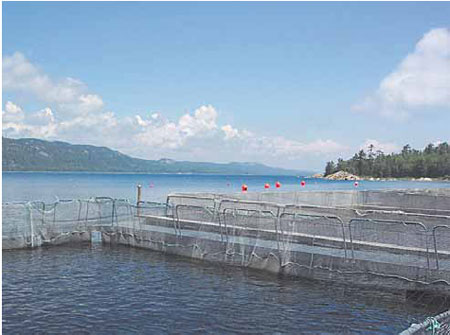
The program looked at fish abundances and stable isotopes in a selected number of fish at five different cage sites in the general vicinity of Manitoulin Island.
If wild freshwater fish in Lake Huron are consuming fish feed and faeces from trout farms of the lake, they're doing so only in such miniscule quantities that it's not altering the ratios of the three most indicative stable isotopes in their bodies, according to a recent study in the area.
According to the lead scientific researcher on the project, Dr. Tom Johnston of the Ontario Ministry of Natural Resources, the results are good news for the lake's fish farmers: the project shows that their operations do attract increased numbers of fish from the wild, but they appear to do so for reasons apart from the sites being seen as a potential food source.
"Our study wasn't designed to demonstrate whether or not it (the pen-site waste) is adversely affecting them, but it doesn't appear to be," said Johnston.
The study, which was funded through OMNR, the Department of Fisheries and Oceans and the University of Waterloo, detected no dietary shift in either the fish or in the zebra mussels, crayfish and larval may-flies the field personnel also collected from the lake floor at the sites for analysis.
Johnston said the program looked at fish abundances and the stable isotopes in a selected number of fish at five different cage sites in the general vicinity of Manitoulin Island.
The field program followed a pilot study carried out in 2002. Using a DFO research boat field personnel set bottom-grounded gillnets at farm sites and at reference locations about one-two kilometers away. The reference sites were chosen to closely match the fish habitat at each farm site for substrate and water depth.
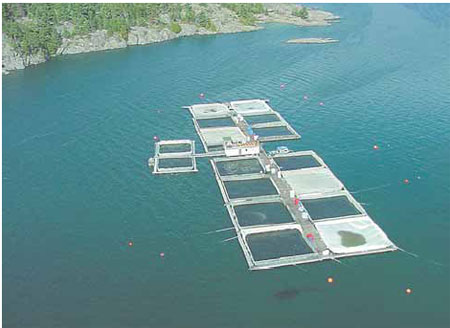
Researchers discovered that wild fish like the pens for non-food reasons, perhaps for shelter against birds and other predators.
Some nets had smaller meshes, while others had larger meshes to catch only the larger fish, but care was taken to ensure consistency in which mesh-size was used where and when.
The two sets of nets were left in place from about 7 p.m. until about 9 a.m. the next day, when they were retrieved and the fish counted, noted for species, measured for length and weight, and some had samples taken for laboratory analysis of their isotope ratios.
Based on this sampling design, Johnston said, the fish farms were shown to have no effect on the fish's isotope ratios, but it was noted that abundances of fish both large and small were greater around the pens than at the reference sites, especially spot-tail shiners, which only grow to about 75-100 mm long.
Apparently, said Johnston, the fish like the pens for non-food reasons, perhaps for shelter against birds and other predators.
"That was pretty consistent across all the sites", said Johnston. "I'd say the abundance was anywhere between about 50 and 100% higher at the pen sites, but you have to remember that fish abundances estimated from gillnet catches are highly variable.
Research team: Tom Johnston, Michael Whittle, Michael Power. For information contact Tom Johnston (Email: tjohnston@laurentian.ca). Submitted by DFO (ACRDP).
Quentin Dodd
Better tasting table fish produced in recirculated water
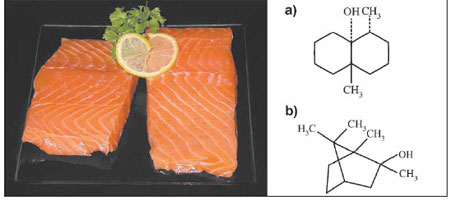
(Left) Fish filets (Right) a) Geosmin b) MIB
Off-flavours in fish flesh are a problem for the aquaculture industry. They affect the quality of the final product. The problem of off-flavours has been observed in pond-raised fish and has now been encountered in fish raised in recirculating systems (RSs). The most frequently encountered off-flavour is described as "earthy/musty" and is caused by the accumulation of two compounds, geosmin and 2-methylisoborneol (MIB), in fish flesh. These semi-volatile compounds are absorbed and stored in lipidrich tissues. Cyanobacteria as well as actinomycetes are known to be sources of geosmin and MIB. A period of purging the fish in fresh water is necessary in order to get rid of off-flavours in the flesh; this period may last for several days and may be longer when the water temperature drops and the percentage of fat in the flesh increases.
The objectives of this project are to identify the microorganisms responsible for the off-flavours in RSs, develop strategies for optimizing the purging period and observe the effect on purging time of different diets with varying amounts of lipids.
Research team: Houle S., Comeau Y., Kharoune M., Le François N., Proulx D., Bourque L., Desmeules A., Proulx É., Higgins S., Schrader K., Summerfelt S., Vandenberg G. For information contact Grant Vandenberg (Email: Grant.Vandenberg@san.ulaval.ca). Submitted by FQRNT.
May '05-Aug. '07
New Brunswick Arctic Charr brood stock development
Arctic charr (Salvelinus alpinus) is an excellent candidate for intensive culture, and it shows good growth performance in cold water. Canada, owing to its geographic location and climate, has significant potential for production of this species.
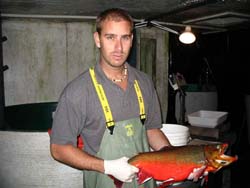
The principal objective of this project is to develop an Arctic charr broodstock with a known pedigree, good growth performance and ability to produce juveniles adapted to local culture conditions.
The long-term goal of the project is to develop a competitive Arctic charr culture industry in eastern Canada. The principal objective of this project is to continue to develop an Arctic charr brood stock with a known pedigree and good growth performance during culture and ability at maturity to produce juveniles adapted to local culture conditions. Adopting a selection protocol that guarantees the transfer of information from the industry to the program and in return optimize the transfer of genetic gains to the industry will attain this objective. Knowledge of the brood stock's pedigree will ensure the maintenance of genetic variability and the control of inbreeding. Whereas identification of the best performing families under real production conditions at the fish farmers' sites will make it possible to refine the selection protocol and develop high-performance gene pools adapted to the industry.
The benefits of such a program will be realized once the industry has access to lines of Arctic charr offering superior zootechnical performance.
Research Team: Claude Pelletier and Annie Ferguson (Coastal Zone Research Institute), Christophe Herbinger (Dalhousie U.), Don Wolverton (NB Trout Farmers Ass'n), and the NB commercial Arctic charr growers. For information contact Brian Glebe (E-mail: GlebeB@mar.dfo-mpo.gc.ca). Submitted by DFO (ACRDP).
Sept. '01-Mar. '06
Shortnose Sturgeon culture begins with growth and diet investigations
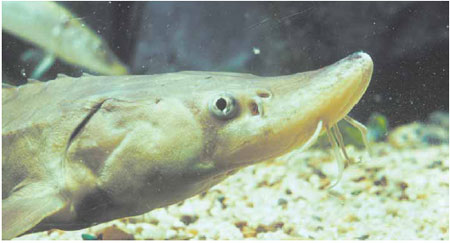
Sturgeon eggs (caviar) and meat are some of the most highly valued fish products in the world with demand continuing to grow. Yet the 27 species of sturgeon worldwide are almost all threatened or endangered. This project has conducted a series of experiments and explored models to accelerate the introduction of shortnose sturgeon for aquaculture in Atlantic Canada. This species can grow to 10 kg in 4-5 years with a minimum caviar yield worth at least $2,000 USD.
Diet development and husbandry techniques that promote high growth and maximize production are keys to developing this species for culture. The first objective has focused on development of a high growth diet. This involves several related areas of investigation. The analysis of body composition at various stages of development and eggs may provide an estimate of the qualitative nutrient requirement and the concentration of key nutrients retained by fish. Other feed-related investigations include digestibility of potential feed ingredients, and protein and energy requirements. On the basis of this work, feed formulation experiments can begin.
Work on developing techniques and technology to promote rapid growth and maximize production has begun by investigating the growth rates of juvenile sturgeon grown at different temperature through ontogeny.
The information generated through this project will enable the industrial partner to develop economic production models and strategies for commercial sturgeon culture.
Research team: Matthew Litvak (UNB), Santosh Lall (NRC - Institute for Marine Biosciences), Larry Hammell (UPEI Atlantic Veterinary College), Suzie Currie (Mount Allison U), Saint Mary's First Nation. For information contact Matthew Litvak (E-mail: Litvak@unbsj.ca). Submitted by AquaNet.
Apr. '04-ongoing
Canola and flax replace fish meal and fish oil in rainbow trout diet

Canola and flax are two abundant Canadian crops that have desirable nutrient properties and a good potential to be used in fish feeds. Both pose numerous challenges, such as insoluble and soluble fibre that prevent immediate use. A newly developed canola protein concentrate (CPC) product with a high level of digestible protein and low levels of antinutritional factors is a promising alternative to fish meal. Flax is the richest plant source of omega-3 fatty acids and an excellent alternative to fish oil which is the currently used source of these essential nutrients.
The first objective of this research project is to determine the effect of long-term feeding of CPC on rainbow trout (Oncorhynchus mykiss) growth rates, feed efficiency, intestinal histology and inflammatory responses. The second objective is to determine the effect of CPC and dehulled flax on flesh quality and reduction of the contamination of farmed fish by organochlorines. The research will measure the level of contamination of individual ingredients including fish meal oil presently used in Canadian aquafeeds. The ultimate goal is to reduce the dependence on wild fisheries for protein and oils in feed formulas, reduce contamination exposure and levels of organochlorines in farmed fish and develop a valueadded industry for abundant Canadian grain products and the commercialisation of canola protein concentrate.
Research Team: Murray Drew (U. Sask.), Andrew Van Kessel (Animal and Poultry Science), David Janz (Veterinary Medical Science). For information contact Murray Drew (Email: drew@sask.usask.ca). Submitted by AquaNet.
Apr. '04-May '06
Sex control in Arctic Charr
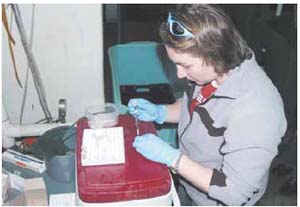
MSc candidate Marcia Chiasson collecting blood sample for ploidy analysis.
Early (pre-harvest) sexual maturation has been identified as a key constraint to commercial charr culture. The integration of all-female diploidand triploid (sterile) charr into a commercial breeding program to reduce or eliminate early maturation of farmed charr is a potential solution.
One line of investigation is the production of triploid charr using pressure treatments identical to those already used in salmon and trout aquaculture. Early survival and growth rates, prior to the onset of maturity in diploids, have shown triploids to be inferior to diploids. However, the expected growth advantage of triploids will not likely be realized until diploids start to mature.
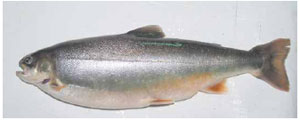
Sterile (triploid) Arctic charr.
Another investigation involves the comparison of steroid (androgen) treatments for sex reversal via pre-feeding immersion or dietary administration. This has shown the optimum treatment for masculinization of charr is a feeding a diet containing 0.5mg/kg of the synthetic steroid 17 -methyldihydrotestosterone for 600 degree days beginning at fi rst feeding. This yields close to a 100% male population. Some of these are genetic females which can be used as broodstock to create all-female populations when crossed to normal females.
Research team: Tillmann Benfey (UNB), Claude Pelletier (Coastal Zone Research Institute), Marcia Chiasson (UNB). For information contact Tillmann Benfey (E-mail: benfey@unb.ca ). Submitted by Atlantic Canada Opportunities Agency - Atlantic Innovation Fund.
Jan. '04-Dec. '06
Measuring sediment to water nutrient flux in lakes with fish farms
The development of freshwater aquaculture is currently limited in Canada by a perceived risk of eutrophication of the lakes in which farms may be located. There are gaps in the sound scientific knowledge regarding the effects of freshwater aquaculture on receiving waters. One of the gaps is the quantification of the nutrient fluxes from the sediments to the water column. Nutrients from fish cage farms usually increase the total nutrient content of the sediments. But such nutrient loading can also increase the concentration of soluble forms which can be released into the overlying water, becoming potentially available to primary producers.
Nutrient fluxes from sediments at two locations in lake 375 (Experimental Lakes Area, Ontario, Canada) are being quantified in order to estimate the overall contribution of the sediments affected by fish wastes to soluble P and N loading and the contribution of these fluxes to eutrophication. Each site has different sediment chemistry, with one site affected and one site unaffected by fish wastes. Major factors affecting the fluxes such as oxygen level and temperature are also being investigated. Using intact cores, the soluble reactive phosphorus, total dissolved phosphorus, total phosphorus, ammonia, nitrate and nitrite and total dissolved nitrogen fluxes are being measured under aerobic and anaerobic water conditions and at various temperatures.
Research team: Paula Azevedo (DFO), Cheryl Podemski (DFO), Gord Cole (Aqua-cage Fisheries Ltd), Mark Wagner (Martin Mills). For information contact Paula Azevedo (E-mail: AzevedoP@dfo-mpo.gc.ca). Submitted by DFO (ACRDP)à
Apr. '06-Mar. '07
Diet formulations and fat content under investigation for yellow perch
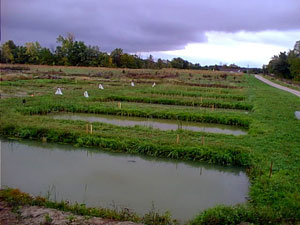
Yellow perch has a strong market demand and remains one of Canada’s most commercially valuable freshwater fish species. Supply is almost entirely based on Great Lakes fisheries with a small contribution from aquaculture production. Currently, limited information exists concerning the optimal diet formulation for yellow perch and no commercially available fin-fish formulation exists for this species. As a consequence, yellow perch aquaculture facilities must decide between formulations specific for salmonids, catfish, or tilapia.
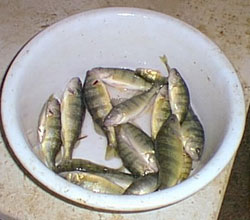
The primary objective of this project is to determine the optimal diet formulation that will maximize perch fillet production under pond reared conditions while limiting the time required for fish to achieve market size (~150g). This study is currently feeding yellow perch three commercial diet formulations consisting of 9%, 16%, and 23% fat contents. Results to date indicate that yellow perch attain fat contents similar to their diet treatments. But they attain substantially higher fat content than wild yellow perch. Much of this excess fat accumulates in large stores around the viscera. This may lead to greater losses of fillet production due to reproductive output. Thus, the second objective of this study is specifically testing if the higher fat salmonid feeds typically used for yellow perch aquaculture contribute to such excess fat accumulation. This effect is being tested by comparing growth, lipid content and gonad development on a monthly basis.
Research team: Gord Paterson, Ken Drouillard, Doug Haffner, and Aaron Fisk (all University of Windsor), Todd Leadley (Leadley Environmental Inc.), Doug Geiling (DFO). For information contact Gord Paterson (E-mail patersj@uwindsor.ca). Submitted by DFO (ACRDP).
Mar. ’05-Aug. ’07
Advancing the culture of walleye in ponds and recirculation systems

Culture techniques are now being developed for one of Canada’s most economically valuable freshwater fish species, walleye (Stizostedion vitreum). The long-term strategy for walleye culture will involve land-based rearing in ponds and recirculation systems.
In order to identify the best wild walleye stock in Ontario for domestication, stock comparisons from Lake Erie, Lake Nipissing and Lake Ontario (Bay of Quinte) were compared. Lake Ontario walleye appear to grow best under culture conditions.
Determining the optimal conditions for the culture of this walleye stock in ponds and recirculation systems is the second objective. Experiments have been done to determine thresholds for oxygen, nitrite and ammonia that will affect the physiology and growth of walleye in closed systems. A moderate level of ammonia in water has been demonstrated to actually promote growth in juvenile walleye. Another series of experiments showed that the growth of walleye is not significantly influenced by changes in environmental salinity. Walleye-specific molecular tools have been developed to monitor growth and stress in very small individuals over short periods of time – which will significantly enhance further research on this species.
Improving broodstock maintenance and inducing spawning in captivity comprise the third objective. Together with the industrial partner, a domesticated broodstock has successfully been developed, as well as a feeding strategy to convert walleye fry to feed on artifi cial diet.
Research team: Bruce Tufts, Yuxiang Wang, Rashpal Dhilon, Barry Madison (all at Queen’s University). For information contact Bruce Tufts (Email: tuftsb@biology.queensu.ca). Submitted by DFO (ACRDP).
Apr. ’02-Mar. ’05
Tracking interactions between wild and farmed rainbow trout in Lake Huron

The potential genetic and ecological effects of cage culture escapes on naturalized and native fish populations are contentious issues. Although the debate has mainly involved marine operations, similar concerns exist for aquaculture in the Great Lake. To address some of these concerns, the Ontario Ministry of Natural Resources (OMNR) and the federal Department of Fisheries and Oceans (DFO) are investigating the ecological and genetic effects of aquaculture operations in Lake Huron on local wild rainbow trout populations.
The project involves the identification of geographic genetic structure among naturalized populations of rainbow trout in Lake Huron and Georgian Bay. The genetic signatures of source stocking and aquaculture populations are also being assessed. The project aims to quantify the range and extent of movement and gene flow among populations and measure the interactions between wild, stocked, and escaped fish. Genetic results from a pilot study in 2005 indicated that previous escape events had occurred but there was little evidence of interbreeding between the escapes and naturalized or domestic fish stocks. Genetic analyses of samples from source stocks and wild-caught rainbow trout collected in 2006 are continuing. This genetic work will be complemented by the addition of acoustic/radio telemetry investigations of rainbow trout movements.
Research team: Chris Wilson (OMNR), Tom Johnston, (OMNR), Doug Geiling (DFO). For information contact Chris Wilson (Email: chris.wilson@mnr.gov.on.ca ). Submitted by DFO (ACRDP).
Apr.’05-ongoing
Using white corn gluten in feeds: a revolution in the world of colour
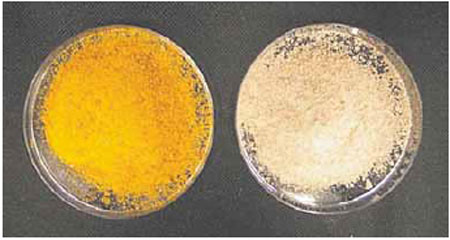
Corn gluten: yellow and white.
Corn gluten is increasingly being used as a protein supplement in feed formulations as a potential replacement for animal proteins. However, it has been established that oxycarotenoids (xanthophylls) in yellow corn gluten occasionally give the flesh of farmed fish a yellowish colour. This pigmentation problem restricts how much yellow gluten can be used in feeds. The primary objective of this study is to test the use of white corn gluten in experimental diets in order to avoid the problems associated with the undesirable yellow colouration of trout flesh. The second objective is supplementation of feed with lysine, an essential amino acid naturally found in corn gluten, in order to improve carotenoid binding in fish flesh via protein deposition.
The results of this study will enable researchers and aquaculturists to gain a better theoretical understanding of the pigmentation of trout flesh as a result of the effect of lysine, while promoting the use of white corn gluten as a low-polluting, non-colouring, high-energy protein source.
Research team: Dagenais G., Desmeules A., Proulx É., Higgins S. and the team of the Laboratoire régional des sciences aquatiques (LARSA), Bureau D., de Francesco M., Vandenberg G. For information contact Grant Vandenberg (Email: Grant.Vandenberg@san.ulaval.ca). Submitted by NSERC.
Sept. ’05-Aug. ’07
Using DNA to determine the phosphorus requirements of rainbow trout
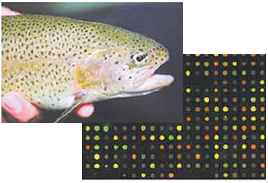
Rainbow trout and DNA microarrays
Phosphorus (P) is a nutrient that is essential to fish growth. It is important to determine actual requirements in order to reduce P discharges, which are responsible for eutrophication of receiving water bodies. Nutritional requirements are usually estimated using empirical methods, relying on indicators whose sensitivity and accuracy may vary, such as growth, feed efficiency, serum P, urinary P and bone P, determined on the basis of feed trials with varying concentrations of the nutrient of interest. Various studies have already shown that the concentration of dietary P is the main regulator of expression of the genes involved in P metabolism in rainbow trout. There may be other P-responsive genes in rainbow trout that can be used to provide more sensitive, faster and more accurate methods of estimating minimum nutritional requirements.
This project aims to develop and use DNA microarrays to study the interaction between diets with varying P levels and P-responsive genes. This project will provide better knowledge about the dietary requirements of rainbow trout and enable us to formulate diets that are better adapted to their physiological needs, thereby minimizing P excretion in aquaculture effluents, an essential condition for the development of sustainable aquaculture in Canada.
Research team: Lake J., Proulx É., Koffi G., Germain G., Robert C., Gravel C., Vandenberg G. For information contact Grant W. Vandenberg (Email: Grant.Vandenberg@san.ulaval.ca). Submitted by NSERC.
Sept. ’04-Jan. ’07
Treating fish farm effluents using a coagulation-flocculation process optimized with chitosan
Chitosan is a soluble polysaccharide that is derived from chitin, a molecule found in abundance in the shells of crustaceans. Marinard Biotech (a marine biotechnology company based in Rivière-au-Renard on the Gaspé Peninsula) is working to develop biomolecular applications for fisheries processing by-products, exploratory work carried out in 2001, realized that industrial-grade chitosan, when used in total replacement of polyacrylamide as a flocculating agent in the treatment of municipal wastewater, reduced the use of aluminum salts by two-thirds, while still meeting environmental standards for effluents.
Research into removing phosphorus from the effluents of fish farms that use open (flow-through) systems and maintaining water quality in fish farms that use closed (recirculating) systems is currently focused on the use of conventional polymers (polyamines, acrylamides and polyacrylamides). The objective of this project was to verify the potential of using chitosan for the treatment of fish farm effluents in the Quebec context.
Compared with the other commonly used flocculants, chitosan has many advantages. First, less chitosan is needed to obtain the same flocculation effectiveness delivered by other chemical flocculants. Second, the flocculation effectiveness of chitosan is maximal at neutral pH values, while most chemical flocculants require acidic pH levels to precipitate. Finally, chitosan is a chelator of heavy metals, has virtually zero toxicity and is biodegradable.
Research team : Francis Dupuis (Marinard Aquaculture Ltée), Aquaculture Côte-Nord inc., Clermont Beaulieu (Marinard Biotech), Sébastien Sauvé (University of Montreal), Mourad Kharoune (École de technologie supérieure), Mélanie Michaud (Pisciculture Côte-Nord inc.), Éric Tamigneaux (Centre collégial de transfert de technologies des pêches). For information contact Clermont Beaulieu (Email: cbeaulieu@marinard.com). Submitted by SORDAC.
Apr.’05-Sept.’05
Elucidating the genomic basis of hybrid vigor in brook trout
Quebec is the world’s main producer of brook trout (Salvelinus fontinalis), a species native to eastern Canada. The objective of this project is to elucidate the physiological and genomic basis of hybrid vigour in brook trout. The approach used in this project integrates quantification of hybrid vigour for several traits of importance to aquaculture production, with a comparative analysis of gene expression profiles and research on endocrine regulators. This allows for the identification of the combinations of genetic lines and thermal regimes that make it possible to derive maximum advantage from the phenomenon of hybrid vigour in brook trout.
Elucidation of the genetic interactions underlying the expression of hybrid vigour will not only improve brook trout aquaculture, but will also enable the development of tools to more accurately predict the expression of this phenomenon in other cultured species and improve salmon farming and aquaculture production in general.
Research team: Louis Bernatchez (Université Laval) Céline Audet and Pierre Blier (Université du Québec à Rimouski), Daniel Cyr (Institut national de recherché scientifi que – Institut Armand-Frappier), Éric Gaudreault (Aquaculture Forestville), Pierre East (Pisciculture de la Jacques-Cartier inc.) For information contact Louis Bernatchez (Email : Louis.Bernatchez@bio.ulaval.ca). Submitted by SORDAC.
Apr.’05-Apr.’08
A new low-phosphorus, high-energy feed for brook trout under investigation
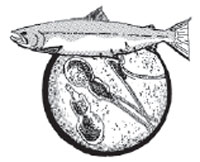
The significant improvement in the quality of feeds, the increase in their energy content and the reduction in the feed conversion index have made possible a very significant reduction in solid waste and phosphorus and nitrogen discharges, and ultimately in feed costs for rainbow trout farmers. However, observations made by brook trout farmers suggest that brook trout (Salvelinus fontinalis) may have a more limited capacity than rainbow trout to use lipids as an energy source when fed high-energy feeds.
The objective of this study is to verify whether replacing lipids by proteins in brook trout feeds affects liver function, consequently reducing growth performance. Nine feeds (matrix of 3 lipid content levels X 3 protein content levels) will be formulated in collaboration with Skretting Canada. Laboratory studies and studies in commercial fish farms will be conducted in order to determine the effect of the feeds on growth performance, liver function (histological and physiological levels), body composition and nutrient discharges.
Research team : Éric Boucher (Interprovincial partnership), Yves Boulanger (Pisciculture des Alléghanys), Francis Dupuis (Marinard Aquaculture), Jean Maheu (Pisciculture Val-des-Bois), François Roberge (Pisciculture Mont-Tremblant), Grant W. Vandenberg (Laval University). For information contact Éric Boucher (Email: Eric.Boucher@san.ulaval.ca). Submitted by SORDAC and DFO (ACRDP).
Apr. ’05-Apr. ’07
Liming improves phosphate removal from fish farm sludge
Removing phosphorus from fish farm effluents is a central element of the sustainable development strategy for freshwater aquaculture in Quebec (STRADDAQ). Most of the phosphorus in culture water originates from uneaten food and fish feces, which are found mainly in particulate form.
Simple treatment processes such as the use of settling areas or rotary drum screens intercepts this particulate material, which forms a sludge of low dry-solid content (high dilution). The sludge must be extracted quickly in order to minimize solubilization of the particulate phosphorus. However, the significant volumes of sludge, combined with the capital costs of storage tanks and of transport for disposal, argue in favour of increasing the dry-solid content of the sludge in order to reduce its volume. Thickening by simple settling takes time and some of the particulate phosphorus solubilizes and is lost in the effluent.
The goal of this research project is to identify the design criteria needed to precipitate the phosphorus and prevent it from solubilizing through the addition of quick lime or slaked lime. Laboratory and field tests are being conducted with synthetic phosphorus solutions and fish farm sludge. The sludge used will be fresh (before solubilization) or collected from the supernatant of the sludge storage silo. The effect of the type of fish feed on phosphorus precipitation efficiency will also be tested. This project should indicate the best form and dose of lime to use, based on the characteristics of the sludge.
Research team : Yves Comeau, Francis Ardelean, and Denis Bouchard (École Polytechnique de Montréal), Robert Champagne and Dominic Marcotte (MAPAQ), Daniel Gagnon (Quebec Department of Sustainable Development, the Environment and Parks - MDDEP). For information contact Yves Comeau (Email: Yves.Comeau@polymtl.ca). Submitted by SORDAC.
Apr. ’05-Jun. ‘06
Genetic control advances the culture of brook charr
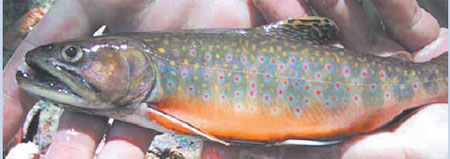
The genetic control of economically important traits in brook charr (Salvelinus fontinalis) has been significantly advanced through this project in a number of ways. First, a classic quantitative genetic approach was employed to estimate the heritability for growth-related traits and maturation and to estimate genetic correlations and predict changes. Second, the genetic and molecular basis for disease resistance and maturation was investigated. Thirdly, a genetic map was created with quantitative trait loci (QTL) for other genes affecting growth traits. Additional work is in progress related to genetic variance, candidate genes for disease resistance and the molecular basis for precocious maturation. In addition, novel molecular tools for the characterisation of several candidate genes were generated, including two growth hormones, several molecular cross-membrane signalling proteins and two loci of the major histocompatibility complex.
This study generated publications in leading research journals such as Aquaculture and Evolution. Partner laboratories in the project have trained over 13 high quality personnel currently working in aquaculturerelated areas. All members of the team are part of the Réseau Aquaculture Québec, which integrates work on endocrinology, molecular and quantitative genetics in charr (Salvelinus spp) and other species. The project was also funded by SODIM (Société de développement de l’industrie maricole Inc.) and SORDAC (Société de recherche et de développement en aquaculture continentale).
Research team: Louis Bernatchez (Université Laval), Céline Audet and Pierre Blier (Université du Québec à Rimouski), Pierre Belhumeur and Daniel Cyr (Université de Montréal). For information contact Louis Bernatchez: (Email: Louis.Bernatchez@bio.ulaval.ca). Submitted by AquaNet.
Apr. ’03-Feb. ‘06
Optimizing waste treatment technology
The systems currently used by Quebec fish farms to treat particulate waste include membrane filters (drum filters), swirl separators and sedimenters. Some fish farmers have also installed new self-cleaning "Cornell-type" tanks. These tanks are equipped with a surface drain and a bottom drain in order to use a low proportion of the water flow to quickly remove fish farm particulate waste through the bottom drain. Concentrating the waste in this way increases the efficiency of the recovery equipment. This rapid recovery of fish farm waste makes it possible to recover a substantial proportion (approximately 70%) of the phosphorus which is also present in solid form. However, because of the different configurations of Quebec fish culture stations, the efficiency of the treatment systems can vary and may be greater or less than the theoretical values.
Implementation of STRADDAQ (Strategy for the sustainable development of freshwater aquaculture in Quebec) requires efficient waste treatment to be in place in a greater number of fish culture operations. The objective of this project is to obtain data on the operation and performance of various treatment systems and culture tanks currently in use in Quebec. This data will help optimize current treatment systems, while providing guidance for the design of future systems for the treatment of fish farm waste.
Research team: Robert Champagne and Dominic Marcotte (MAPAQ), 7 fish farmers. For information contact Robert Champagne (Email: Robert.champagne@mapaq.gouv.qc.ca). Submitted by SORDAC.
Apr. ’05-Jun. ‘06
More stable fish feces in water: a plus for the environment
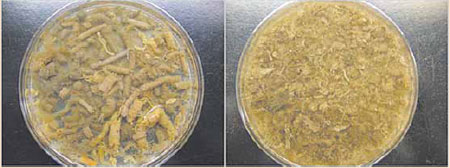
Feces of brook trout fed with different feeds.
One of the strategies being studied to reduce the environmental impacts of fish farm effluents from landbased facilities (in freshwater primarily) is to quickly separate feces (solid matter) as soon as they are produced by the fish. This can prevent solubilization of the phosphorus and nitrogen contained in the feces, thereby minimizing the growth of algae-cyanobacteria and eutrophication of receiving water bodies. Phosphorus is the main factor limiting algal growth in freshwater, and feces contain 60% to 80% of the total phosphorus excreted by fish, with the rest present in soluble form, hence the importance of keeping the phosphorus contained in feces captive.
This project has two objectives: first to develop a reliable and reproducible method of measuring feces stability, and second to test different feed additives in order to substantially increase the stability of feces in water.
Research team: Vandenberg G., Lamarche M.-C., Comeau C., Kharoune M., Lambert R., Le François N., Lessard P., Proulx D., Desmeules A. For information contact Grant Vandenberg (Email: Grant.Vandenberg@san.ulaval.ca Submitted by FQRNT.
Jul. ’04-Jul. ’07
- Date modified: